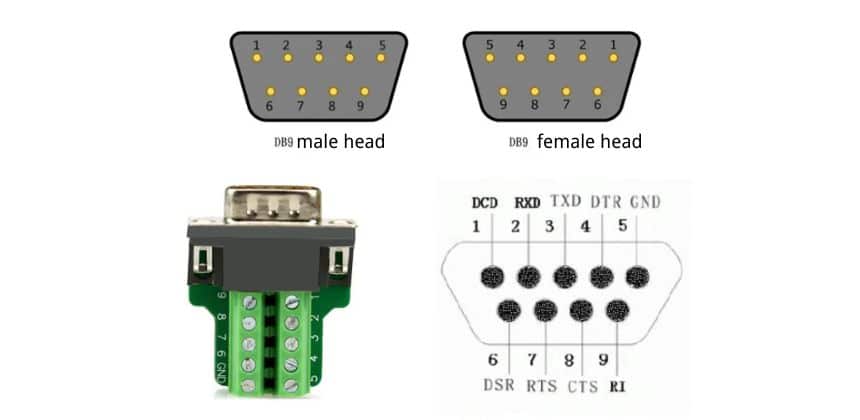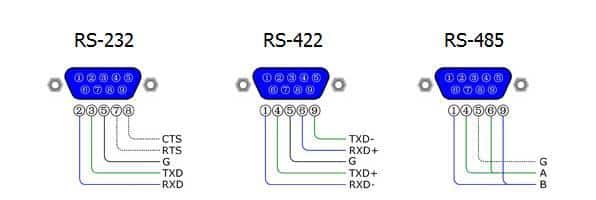RS232 is a serial communication standard commonly used in the field of water treatment instrumentation manufacturing to connect data transmission between water treatment equipment and computers or monitoring systems. Through the RS232 interface, water treatment equipment can realize data acquisition, monitoring, control and storage, helping manufacturers to realize the automated management of the production process and data analysis, improve production efficiency and product quality.
Overview of RS232
RS232 is a serial communications standard used to transfer data between computers and external devices. It derives its name from “Recommended Standard 232”, a set of standards developed by the Institute of Electrical and Electronics Engineers (IEEE) to define the electrical characteristics, signaling formats, and communication protocols for serial communication interfaces.RS232 was first developed in the 1960s and became a widely used standard in the 1970s.
The RS232 standard defines the physical and data link layers for data transmission. At the physical layer, RS232 uses a set of electrical characteristics to define the voltage level, transmission rate, and connection method of the signal, usually using a DB9 or DB25 interface connector. On the data link layer, RS232 defines the format of the data, including the number of data bits, start bit, stop bit, and parity bit. It uses asynchronous communication, which means that there is no fixed time interval between each data byte, but rather the start and end of the data is determined by the start bit.

The basic principle of RS232 is data transfer over a single transmission line. The data is divided into bytes, each of which consists of a series of bits, and transmitted serially. The sender converts the data to serial format and sends it over the transmission line to the receiver, who converts the serial data to parallel format and processes it.
Although modern computers often use more advanced communication interfaces such as USB, Ethernet, etc., RS232 is still widely used in some older devices or specific areas of communication needs, and is favored for its simplicity, stability and reliability.
Differences between RS232 and other serial communication standards
| Serial Communication Standard | Electrical Characteristics | Connection Method | Data Transfer Rate | Key Advantages | Applications |
| RS232 | Positive and negative 12V | Point-to-point | Low to several tens of kbps to hundreds of kbps | Simple and reliable, widely used in legacy equipment | Serial printers, older modems |
| RS485 | 0V and 5V | Multi-point | Several hundred kbps to several Mbps | Longer transmission distances, better noise immunity | Industrial control systems, remote data acquisition systems |
| RS422 | 0V and 5V | Point-to-point | Several hundred kbps to several Mbps | Better noise immunity | Industrial control systems, data communication systems |
| TTL | 0V and 5V | Point-to-point | High | Suitable for short-distance transmission between digital electronic devices | Microprocessors, sensors |
| USB | 5V | Point-to-point | High to several Gbps | Widely used for computer peripheral connections | Mice, keyboards, storage devices |
| Ethernet | 5V | Multi-point | High to several Gbps | Used for local area network and internet connections | Local area networks, internet |
| SPI | 0V and 5V | Point-to-point | Adjustable | Used for data transmission between microcontrollers and external devices | Flash memory, sensors |
| I2C | 0V and 5V | Multi-point | Adjustable | Used for data transmission between microcontrollers and external devices | Temperature sensors, accelerometers |

RS232 features and key technical specifications
Features:
- Simple and easy to use: RS232 interface is relatively simple, easy to realize and debug, suitable for some simple serial communication applications.
- Stable and reliable: RS232 communication is stable and reliable, the transmission distance is shorter, suitable for some requirements of the transmission distance is not long and the data transmission rate is not high scene.
- Point-to-point connection: RS232 usually adopts point-to-point connection, i.e. one-to-one connection, which is suitable for connecting two devices for data transmission.
- Voltage level: RS232 signals use positive and negative 12V voltage levels to indicate logic 1 and logic 0, where positive voltage indicates logic 0 and negative voltage indicates logic 1.
Main technical specifications:
- Electrical characteristics: RS232 defines the electrical characteristics of the signal, including voltage level, transmission rate, and connection method. Usually use DB9 or DB25 interface connector.
- Data format: RS232 defines the format of data transmission, including the number of data bits, start bit, stop bit, check bit, etc.. Asynchronous communication is usually used.
- Data transmission rate: RS232 supports a variety of transmission rates, usually between tens of kbps to hundreds of kbps, the specific rate can be adjusted according to application requirements.
- Transmission distance: RS232 communication distance is relatively short, usually a few meters, but can be extended through the use of repeaters and other equipment to extend the transmission distance.
Specific application scenarios for RS232 in water treatment instrumentation
- Data acquisition and monitoring: Water treatment instruments are usually used to monitor water quality parameters (such as PH, dissolved oxygen, turbidity, etc.), flow, pressure, etc. The RS232 interface can be used to transmit the collected data to a computer or monitoring system for real-time monitoring and recording. Through RS232 interface, the meter can send data regularly, including real-time data and historical data, to help users understand the water quality condition and system operation status.
- Remote monitoring and control: The RS232 interface can also be used to remotely monitor and control water treatment equipment. By connecting with a computer or monitoring system, users can remotely monitor the water treatment process, adjust parameters and execute commands to realize remote control and management of water treatment equipment. This remote monitoring and control function helps to improve the operation efficiency and response speed of the water treatment system, and reduce manual intervention and maintenance costs.
- Data transmission and storage: The RS232 interface can also be used for data transmission and storage. The water treatment instrument can transfer the collected data to a computer or data storage device through the RS232 interface for further analysis, processing and storage. The data can be used to generate reports, develop operational strategies, perform trend analysis, etc., which helps to improve the operational efficiency and management of the water treatment system.
- Equipment interconnection: in the water treatment system, different instruments and equipment usually need to exchange data and work together, RS232 interface can be used to realize the data interconnection between different equipment, to promote the coordinated operation of the various parts of the system and information sharing. For example, water quality monitoring instruments can exchange data with controllers, metering pumps and other equipment to realize automated control and regulation.
Summary
Overall, RS232, as a traditional serial communication standard, still plays an important role in many fields, although it may seem a bit outdated in modern communication technology. Its simplicity, stability and reliability make it still widely used in some specific application scenarios. Although we have seen the emergence of new communication standards such as USB, Ethernet, etc., but the influence of RS232 has not been reduced. Therefore, even in today’s rapidly changing communication technology, we can still see RS232 in some old equipment and specific industries play an irreplaceable role.
Apure offers water quality monitoring instruments, flow measurement instruments, level measurement instruments, pressure measurement instruments, and temperature measurement instruments. Please contact us for more information.
